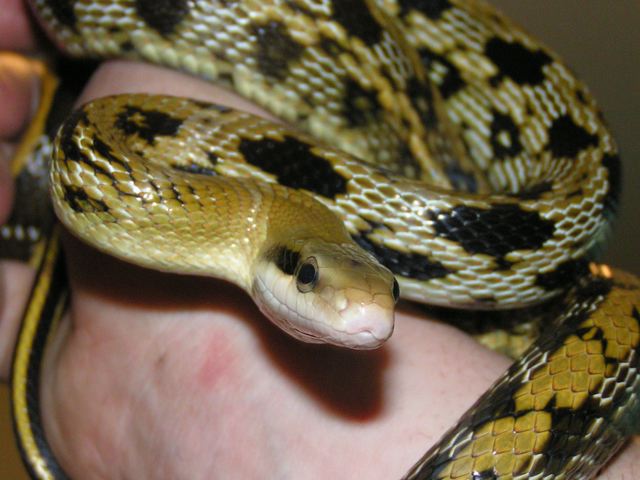 In 1969, Carl Kauffeld introduced a generation of budding herpetologists to snake-keeping with his wonderful classic Snakes: The Keeper and the Kept. In it he laid out the basic principals that had yielded him decades of success while curator of the well-known reptile collection at New York City’s Staten Island Zoo – simple, easily cleaned enclosures that provide a secure retreat and basking site. Such became, and largely remains, the standard approach to snake-keeping in the USA.
In 1969, Carl Kauffeld introduced a generation of budding herpetologists to snake-keeping with his wonderful classic Snakes: The Keeper and the Kept. In it he laid out the basic principals that had yielded him decades of success while curator of the well-known reptile collection at New York City’s Staten Island Zoo – simple, easily cleaned enclosures that provide a secure retreat and basking site. Such became, and largely remains, the standard approach to snake-keeping in the USA.
European zookeepers and hobbyists, by contrast, favor planted, naturalistic exhibits, and it was to these I gravitated. Although not nearly as easy to maintain as bare cages, for certain snakes I find complex terrariums to be a very worthwhile undertaking.
Possible Pitfalls
Cleanliness and the control of excess moisture and parasites can be major concerns…one of my first mistakes involved keeping a banded watersnake in a filtered aqua-terrarium. The animal was not able to dry off sufficiently, and developed blisters. Then Bronx Zoo curator Wayne King (imagine the curator of a major reptile department personally answering a 10 year-old’s letter today!) suggested some changes, and the snake recovered.
Candidates for Naturalistic Terrariums
 In my experience, small species are the best to start with when attempting naturalistic snake terrariums. Such animals are easier on plants and decorations, and secretive snakes really do seem much more “at home” in captive habitats that offer numerous burrowing and hiding opportunities.
In my experience, small species are the best to start with when attempting naturalistic snake terrariums. Such animals are easier on plants and decorations, and secretive snakes really do seem much more “at home” in captive habitats that offer numerous burrowing and hiding opportunities.
DeKay’s (brown) snakes do wonderfully in forest-themed tanks, and often breed readily. Other favorites of mine include smooth and keeled green, garter, ribbon, ring-necked, red-bellied and tentacled snakes.
Larger species are more easily maintained in simple set-ups, especially if space is limited, but there are still some possibilities. Watersnakes will bask on branches over-hanging a pool, just as in the wild, and corn and various ratsnakes will utilize just about every bit of cage furniture provided. Shy or high-strung arboreal species, such as green tree pythons and Cook’s tree boas, also favor well-planted terrariums perched with natural tree branches.
The Staten Island Zoo’s Reptile House Today
 In an odd twist of fate, I recently had the opportunity to help plan the complete renovation of Mr. Kauffeld’s amazing building. Having grown up near to and in awe of the man and the institution, it was quite an odd feeling, to say the least. I set up naturalistic exhibits for nearly all of the snakes, but a re-creation of Mr. Kauffeld’s office holds a number of terrariums set up as he would have wanted. I sincerely hope he approves! Please visit if you have a chance…I would greatly appreciate your comments.
In an odd twist of fate, I recently had the opportunity to help plan the complete renovation of Mr. Kauffeld’s amazing building. Having grown up near to and in awe of the man and the institution, it was quite an odd feeling, to say the least. I set up naturalistic exhibits for nearly all of the snakes, but a re-creation of Mr. Kauffeld’s office holds a number of terrariums set up as he would have wanted. I sincerely hope he approves! Please visit if you have a chance…I would greatly appreciate your comments.
Please Note: some of the photos accompanying this article feature venomous snakes. These are presented as illustrations of terrarium set-ups that might be useful for animals from similar habitats, not as an inducement to keep venomous snakes at home. Venomous snakes should never, under any circumstances, be held in captivity outside of a professionally managed scientific institution.
Many zoos use complex exhibits as a means of providing behavioral stimulation to snakes. Read more at:
http://reptilebehavior.com/riverbankspaper.htm
 That Reptile Blog – Reptile, Amphibian and Exotic Pet Care and Information
That Reptile Blog – Reptile, Amphibian and Exotic Pet Care and Information

 Space and Physical Requirements
Space and Physical Requirements An article to be published later this month (Zootaxa; August, 2008) will announce that a newly described Thread Snake from the Caribbean island of Barbados is the smallest of the world’s 3,100+ snake species. The Barbados Thread Snake grows to a mere 4 inches in length, is no thicker than a strand of spaghetti, and can coil comfortably atop a quarter. It subsists largely upon ant and termite larvae, and may be threatened by habitat loss. A relatively large hatchling – ½ of the adult size – emerges from the single egg laid by the female (perhaps there is no prey species tiny enough to support a larger brood of smaller-sized young).
An article to be published later this month (Zootaxa; August, 2008) will announce that a newly described Thread Snake from the Caribbean island of Barbados is the smallest of the world’s 3,100+ snake species. The Barbados Thread Snake grows to a mere 4 inches in length, is no thicker than a strand of spaghetti, and can coil comfortably atop a quarter. It subsists largely upon ant and termite larvae, and may be threatened by habitat loss. A relatively large hatchling – ½ of the adult size – emerges from the single egg laid by the female (perhaps there is no prey species tiny enough to support a larger brood of smaller-sized young).